If you’ve ever wondered what happens when you mix garlic and honey and let them sit together for a while, you’re not alone. Fermented garlic honey is one of those traditional remedies that feels almost magical and, honestly, is pretty easy to make at home. This blend packs a punch when it comes to flavor and possible health benefits, and it’s something I like to keep in my kitchen just in case sniffles or a sore throat show up.
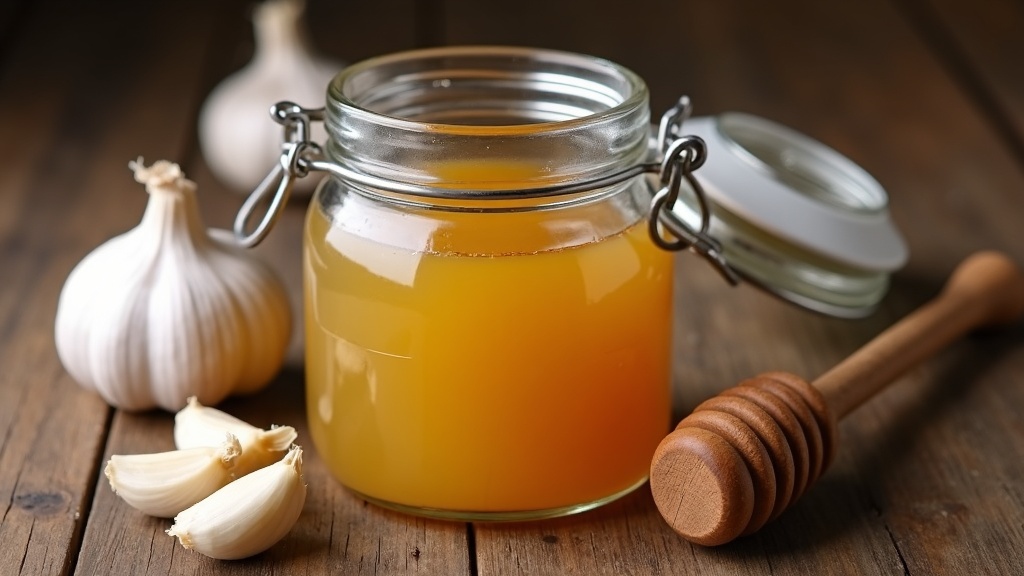
Fermented Garlic Honey: What Makes It Special?
Combining garlic and honey goes way back in history. Both are praised for their natural uses, with garlic providing its pungent, spicy flavor and possible immune-supporting properties, and honey delivering its soothing, sweet, and antimicrobial vibe. Letting these two mix together over time creates something totally unique. The end result is a syrupy, caramel-colored jar of goodness that tastes sweet, slightly tangy, and a little spicy, with mellow garlic notes throughout.
During fermentation, the natural sugars in honey interact with the garlic, causing the mixture to bubble gently as beneficial bacteria work. The result is a raw, living food that’s shelf stable, easy to store, and surprisingly versatile. Before we get into how you can make your own fermented garlic honey, let’s check out some basics and helpful tips about the fermentation process.
How Long Should You Let Garlic and Honey Ferment?
Fermenting garlic in honey isn’t a strictly timed process, but there are general guidelines I like to follow. Once you combine peeled garlic cloves with raw honey in a clean jar, you’ll notice it starts bubbling within a few days. This is totally normal and means fermentation is happening.
Here’s how I usually time it:
- First week: The most active fermentation, with lots of bubbles. The honey may become more liquid as the garlic releases juice.
- 2 to 3 weeks: The garlic will mellow, and the flavors start blending. You can start tasting after 2 weeks, but it keeps getting better as time passes.
- 3 weeks and beyond: I like to let mine sit for at least a month. Some let it ferment for several months or even longer. The mixture becomes more complex and mellow as it ages.
Fermented garlic honey is safe to use after a couple of weeks, but the taste and texture improve the longer you wait.
Tips for Safe Fermentation (And How to Avoid Botulism)
Food safety is important, especially when fermenting at home. Fermenting garlic in honey is generally safe since honey’s natural antibacterial properties do most of the work, but a few best practices help ensure a tasty result you can enjoy.
- Use raw honey: Unpasteurized, raw honey is full of living enzymes and natural yeast that help the fermentation along. Pasteurized honey doesn’t work as well.
- Keep garlic submerged: Make sure all cloves stay coated in honey. Flip or gently turn the jar daily—especially at the start—to keep everything covered and release air bubbles.
- Clean tools and jar: Always start with a clean glass jar and utensils so you aren’t introducing unwanted bacteria or molds.
- Let air escape: Fermentation creates gas. Loosen or “burp” your jar every day during the first week by unscrewing the lid a bit to let air out and prevent pressure buildup.
- Store at room temperature and out of the sun: Darkness and coolness help support a steady, slow fermentation.
If you use raw honey, keep it clean, and let air escape, botulism is extremely rare. If you notice off smells, mold, or odd textures, play it safe and toss the batch. If you want more super-detailed info, check out the National Center for Home Food Preservation.
Recipe: How to Make Fermented Garlic Honey
This is one of those kitchen projects that just about anyone can do. You don’t need fancy gadgets or previous fermenting experience. Here’s how I make mine at home:
- 1 cup raw garlic cloves (peeled)
- 1 to 1.5 cups raw, unpasteurized honey (enough to fully cover cloves)
- A clean glass jar with a lid
Instructions:
- Peel all your garlic cloves. Gently smash them with the side of a knife to help them release juice, if you like—this speeds up fermentation, but it’s not required.
- Put the cloves in your jar, making sure you leave about an inch at the top.
- Pour enough raw honey over the garlic to completely cover every clove.
- Close the jar loosely, or use a lid that isn’t tightly screwed on. Place the jar on a small plate, since it might bubble over in the early days.
- Keep at room temperature and out of direct sunlight. Turn, tip, or flip the jar every day for the first 2 weeks and “burp” the lid each day.
- After around 3 weeks, taste the honey and a clove. Garlic should be mellow and the honey more runny.
- Once you like the taste, you can store the jar in the fridge if you want, but it’s fine at room temperature for months as long as all the garlic stays covered in honey.
This recipe is flexible and easy to double or halve for different jar sizes or needs. The most important part is keeping those cloves submerged in honey for safety and flavor.
How to Use Fermented Garlic Honey
This natural remedy isn’t just good by the spoonful when you feel a cold coming on; it’s amazing in meals and a real secret weapon for creative recipes. Here are some of my favorite ways to put it to work:
- Straight-up by the spoon: A spoonful of honey plus a clove is a nice boost if you feel a sore throat or cough coming your way.
- Mix into tea: Stir a spoonful of honey (garlic optional) into warm tea for a sweet, garlicky twist. Tastes especially good with ginger or lemon teas.
- Salad dressings: Smash up a garlic clove and a bit of honey into oil and vinegar for a lively, garlicky vinaigrette.
- Marinades and glazes: Brush the honey over chicken, tofu, or roasted veggies—smashed garlic cloves add even more zing.
- Spread on bread or cheese: Honeyed garlic has a special kick on sourdough, crackers, and creamy cheeses.
Let your imagination run wild. This jar often comes in handy when I’m experimenting in the kitchen—give it a try on pizza, add to sauces, or swirl into yogurt for a wild treat.
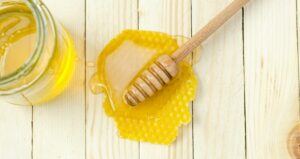
How Often Should I Take Fermented Garlic Honey When Sick?
Dosing with kitchen remedies is more about comfort and your own rhythm than following a set rule. When I’m feeling under the weather, I usually take a small spoonful of the honey and might eat a garlic clove (once or twice a day). If you’re new to garlic, start small and watch how your body reacts, since raw garlic is pretty strong and can be intense for some people.
Fermented garlic honey can be enjoyed for a week or two when cold or flu symptoms show up, but always listen to your body. If anything feels off or symptoms stick around, check in with a healthcare pro. This remedy helps support your system but isn’t a substitute for professional medical care if you need it.
What to Know Before Trying Homemade Ferments
Trying out homemade ferments can be a blast, but I always keep a few basics in mind. Raw honey and garlic can get messy, especially during the bubbling first week, so I keep a plate under my jar. I make sure everything’s clean and the garlic stays covered in honey. Watch out for anything that looks off, like mold, weird color, or an odd smell (other than garlicky). If in doubt, toss it and start over—no harm in trying again.
Why Garlic and Honey?
This combo is about more than flavor. Garlic is famous for compounds like allicin, which gives it the punch, while real, raw honey has special enzymes and traces of pollen and propolis. Mixing them creates something fun to experiment with, and lots of folks swear it supports wellness. You’ll come across fermented garlic honey in herbal books, natural remedy circles, and countless online blogs (Healthline: Fermented Garlic Honey).
Frequently Asked Questions
How long does fermented garlic honey keep?
As long as the garlic is submerged and the jar is clean, it can last for several months at room temperature—sometimes even longer. Cooler storage will slow fermentation, but it’s not required unless you like that texture.
Does fermented garlic honey need to be refrigerated?
No, but putting it in the fridge after a few weeks can slow fermentation and help keep the honey thick. Just make sure all garlic remains covered by honey.
What if my honey crystallizes?
That’s perfectly normal. Warm the jar gently in a bowl of warm water and give it a stir, or just scoop out as you need.
Can I use regular grocery store honey?
You want raw, unfiltered honey. Most standard grocery brands are pasteurized, which isn’t as good for fermenting.
Wrapping Up
Fermented garlic honey is the kind of remedy that’s old-school and modern all at once. It’s simple to make, flexible in how you use it, and adds a sweet-garlicky pop to all kinds of dishes. Whether you’re hoping for a wellness boost or want to check out a new flavor adventure, it’s worth having a jar in your pantry. Try it out—you may find it becomes one of your kitchen staples, too.
© 2025, Teresa. All rights reserved.
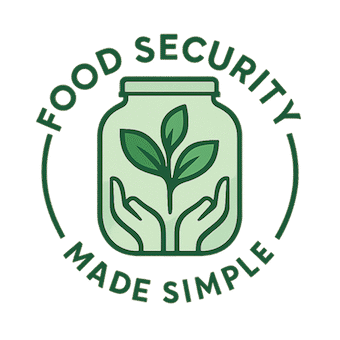
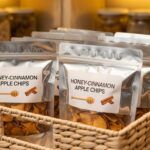




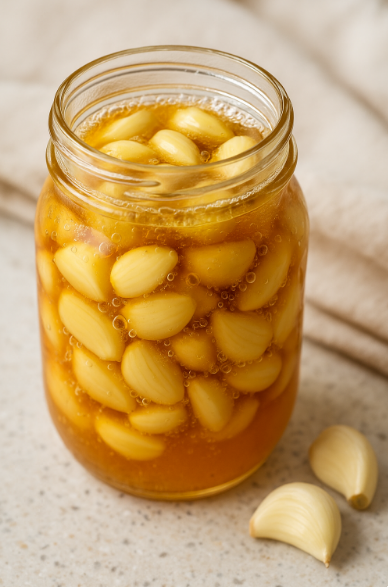

Hi, I like your idea about fermented garlic honey, I think it’s a wonderful and natural way to ward off flu’s and viruses.
Can you use Manuka honey, and will it work with this honey type? I am excited to start this idea which I believe is the most cost effective way to stay healthy and virus free.
Look forward to learning new ideas about healthy recipies and ways to use up garden herbs etc.
Thank you, Helen
Hi Helen! Yes, you can use Manuka honey — it will work just as well and even adds its own extra benefits. Fermented garlic honey is such a simple, powerful remedy, and it’s a great way to put garden herbs to good use too. Excited for you to give it a try! ????????
I love this! Garlic and honey are two of my favourite go-to remedies, but I’ve never actually tried fermenting them together. The way you described the flavour → sweet, tangy, mellow garlic, makes me want to start a jar right away.
I’m especially curious about the “use it straight off the spoon” tip for sore throats. Do you find the garlic itself mellows enough that it’s pleasant to eat, or is it still quite strong after a few weeks of fermenting?
So glad this inspired you! The garlic does mellow quite a bit as it ferments—it’s softer, sweeter, and not nearly as sharp, which makes it much easier (and tastier) to eat straight from the jar.